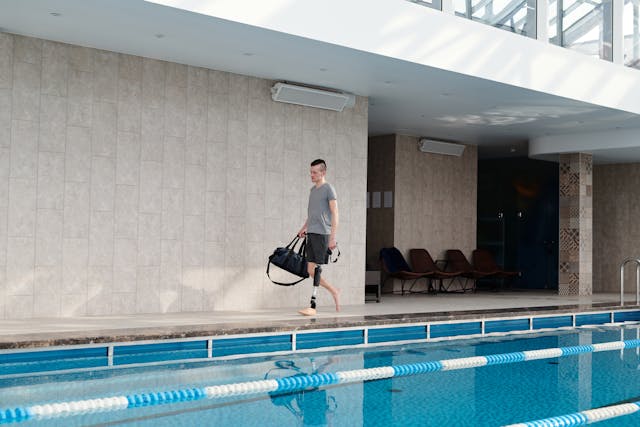For many children, water is a source of joy. Whether it’s playing in the rain, swimming in a pool, or running along the beach, water activities are an essential part of childhood. But for kids with prosthetic limbs, water can be a major limitation. Traditional prosthetics are not designed to handle moisture, which means children often have to remove their prosthetic before engaging in water-related activities.
This is where waterproof prosthetics come in. Designed to resist water damage, provide better grip, and offer freedom of movement, these specialized prosthetics allow kids to swim, bathe, and play in water without worry. But are they worth the investment? Do they truly improve a child’s quality of life?
At Robobionics, we believe every child deserves to live without restrictions. In this article, we’ll explore the benefits, challenges, and considerations of waterproof prosthetic limbs for children—helping parents make an informed decision about whether they are the right choice for their child.
1. What Are Waterproof Prosthetics?
A waterproof prosthetic is designed to withstand exposure to water without rusting, deteriorating, or losing functionality. Unlike standard prosthetics, which can be damaged by moisture, these specialized limbs allow children to participate in water activities safely and comfortably.
Materials Used in Waterproof Prosthetics
Waterproof prosthetics are made from non-corrosive, lightweight materials that prevent water damage. Common materials include:
- Carbon fiber – Strong, lightweight, and resistant to water.
- Titanium – Rust-proof and durable, often used in prosthetic joints.
- Water-resistant plastics – Prevents absorption and keeps the prosthetic dry.
- Silicone liners – Seals the limb connection and prevents water from seeping in.
These materials ensure that the prosthetic remains functional and long-lasting, even after regular exposure to water.
How They Differ from Regular Prosthetics
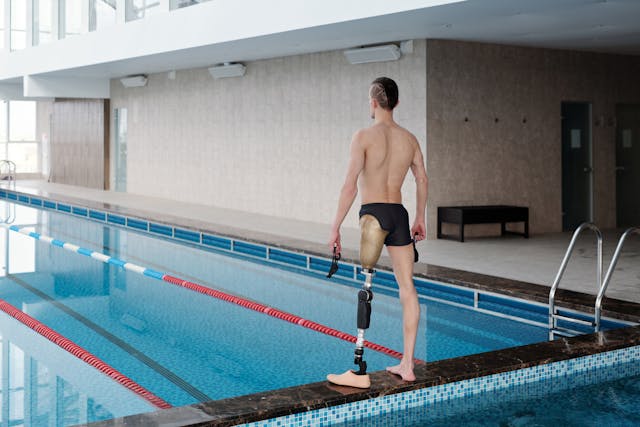
Unlike standard prosthetic limbs, which can absorb moisture, rust, or develop mold, waterproof prosthetics have sealed joints, drainage systems, and water-repellent coatings to keep them fully operational in wet conditions.
A traditional prosthetic may stop working or become uncomfortable if it gets wet, but a waterproof prosthetic is built specifically for water exposure, making it ideal for activities like swimming, bathing, and outdoor play.
Types of Waterproof Prosthetics
There are different types of waterproof prosthetics depending on a child’s needs:
- Swimming prosthetics – Designed with specialized foot and hand designs for better movement in water.
- Everyday waterproof limbs – Built for general exposure to water, such as showers, rain, or beach trips.
- Hybrid models – Prosthetics that function both in and out of the water, offering flexibility for active children.
These options allow kids to enjoy different activities without worrying about their prosthetic getting damaged.
2. The Benefits of Waterproof Prosthetics for Kids
A waterproof prosthetic can transform a child’s lifestyle, giving them the ability to enjoy water-related activities freely.
Freedom to Swim and Play Without Restrictions
Many children with prosthetics avoid swimming, water parks, or beach vacations because their standard prosthetic is not designed for water use. This can make them feel left out when their friends or siblings are having fun.
With a waterproof prosthetic, children can jump into the pool, run through sprinklers, or even learn to surf without hesitation. It eliminates the need to remove their prosthetic, allowing them to move naturally in water.
Improved Hygiene and Convenience
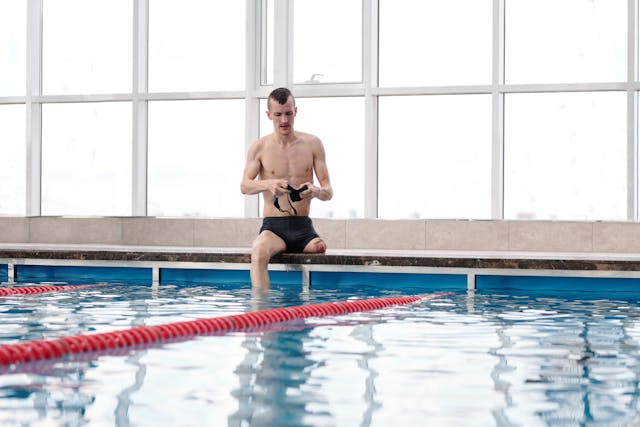
For kids with standard prosthetics, activities like bathing and showering can be complicated. Parents often have to remove the limb, clean the residual limb separately, and then reattach the prosthetic afterward. This process can be frustrating and time-consuming.
A waterproof prosthetic simplifies hygiene by allowing kids to shower and bathe while keeping their prosthetic on, making daily routines easier and more comfortable.
Longer Prosthetic Lifespan
Moisture can cause serious damage to standard prosthetics, leading to rust, weakened materials, and bacterial growth. Repeated exposure to water can reduce the lifespan of a prosthetic, resulting in frequent repairs or replacements.
Waterproof prosthetics, on the other hand, are designed to resist water damage, ensuring that they last longer. This means fewer repair costs and less downtime due to maintenance issues.
3. Challenges and Considerations of Waterproof Prosthetics
While waterproof prosthetics offer many benefits, there are a few challenges and considerations to keep in mind before making a decision.
Higher Cost Compared to Standard Prosthetics
Waterproof prosthetics often cost more than regular prosthetics due to specialized materials, advanced sealing techniques, and added durability features.
However, when considering the long-term benefits, the investment can be worth it. Fewer replacements, reduced repair costs, and increased usability make waterproof prosthetics a valuable choice for active children.
Potential Fit and Comfort Adjustments
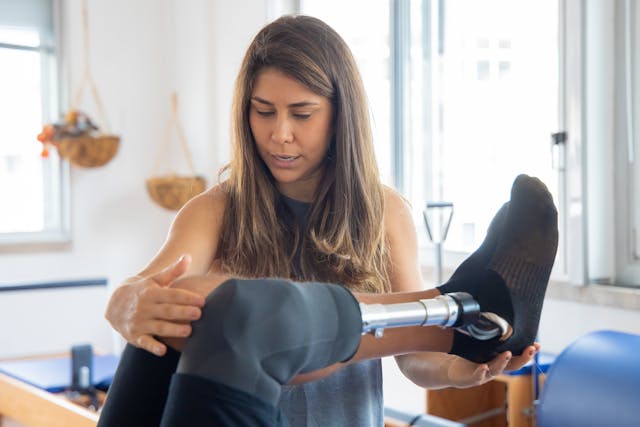
Because waterproof prosthetics have specialized seals and materials, they may feel different from standard prosthetics. Some children may need time to adjust to the new fit, especially when using a prosthetic for swimming.
Additionally, water exposure can affect how the prosthetic grips the skin, requiring extra care to ensure a secure and comfortable fit. Working with a prosthetist experienced in waterproof designs ensures that the limb fits properly and functions optimally.
Limited Options in Some Regions
While waterproof prosthetics are growing in popularity, they may not be widely available in all locations. Parents should research clinics and manufacturers that specialize in waterproof designs to ensure their child gets the best options available.
At Robobionics, we are committed to providing affordable, high-quality waterproof prosthetic solutions, ensuring that children across India can access advanced prosthetic technology.
4. How to Choose the Right Waterproof Prosthetic for Your Child
If you’re considering a waterproof prosthetic for your child, it’s important to choose the right model based on their lifestyle, activities, and specific needs.
Assessing Your Child’s Activity Level
Before selecting a prosthetic, consider how often your child engages in water-related activities.
- If they love swimming, a swim-specific prosthetic with buoyant materials may be ideal.
- If they need general water resistance for showers, rain, or beach trips, a versatile everyday waterproof prosthetic may be better.
- If they participate in multiple sports and outdoor activities, a hybrid model that works both in and out of water is the best choice.
Consulting a Prosthetist for Custom Fitting
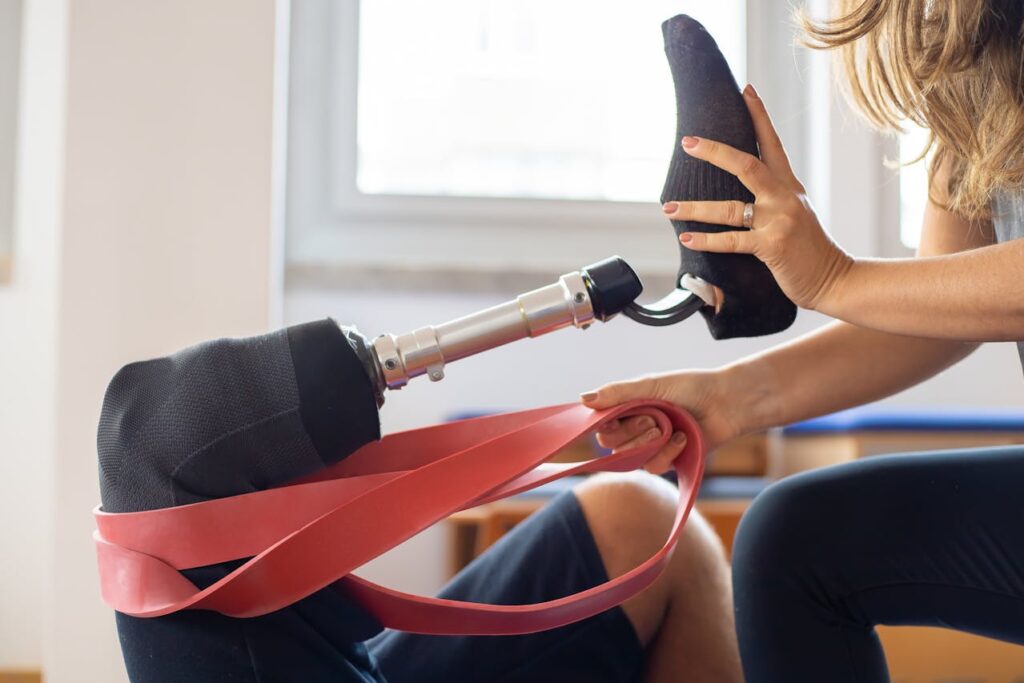
A proper fit is essential for comfort and function. Work with a prosthetist who specializes in waterproof prosthetics to ensure that the limb fits securely and provides natural movement.
At Robobionics, we provide custom fittings and expert guidance to help parents select the best waterproof prosthetic for their child’s unique needs.
Considering Future Adjustments and Growth
Since children grow quickly, it’s important to choose a prosthetic that allows for adjustments. Look for modular designs that can be modified or expanded as your child grows, reducing the need for frequent replacements.
5. Helping Your Child Adjust to Their Waterproof Prosthetic
Even if your child has experience with a standard prosthetic, using a waterproof one may feel different at first. Helping them transition smoothly will ensure they feel comfortable and confident in water-based activities.
Starting with Short Sessions in Water
Just like learning how to walk or balance with a new prosthetic, children need time to adjust to movement in water. Start with short sessions where they can practice basic movements in a controlled environment, like:
- Standing in shallow water to get used to the buoyancy and pressure.
- Walking along the edge of a pool or on wet surfaces to test grip and balance.
- Slowly submerging their prosthetic to feel how it moves in water.
Encourage patience and practice. Over time, they will become more comfortable and natural with their movements.
Addressing Initial Discomfort or Concerns
Some children may find that their waterproof prosthetic feels different than their regular limb—it may be slightly heavier, have different traction, or feel cooler against the skin.
Reassure them that this is normal and will improve with time. If they experience chafing or discomfort, consult their prosthetist to adjust the fit or try different liner materials for better comfort.
At Robobionics, we offer customized fittings and adjustments to ensure that every waterproof prosthetic is tailored for the child’s unique comfort and movement needs.
Encouraging Exploration and Fun

A waterproof prosthetic shouldn’t just be seen as a medical device—it should be something that enhances play and adventure. Encourage your child to try new activities with their prosthetic, such as:
- Jumping through sprinklers on a hot day.
- Building sandcastles at the beach without worrying about water exposure.
- Wading through streams or playing in puddles after the rain.
The more fun and engaging their experiences are, the more they will see their prosthetic as a tool for independence rather than a limitation.
6. Proper Care and Maintenance of a Waterproof Prosthetic
A waterproof prosthetic is designed to resist water damage, but regular care and maintenance are essential to keep it in top condition.
Rinsing and Drying After Use
Even though the prosthetic is waterproof, chlorine, saltwater, and dirt can still cause buildup and wear over time. After every water activity, follow these steps:
- Rinse the prosthetic with clean water to remove any salt, chlorine, or debris.
- Dry it thoroughly using a soft towel, focusing on joints, seals, and attachment areas.
- Check for trapped water in any drainage holes or compartments to prevent bacteria buildup.
Regular cleaning prevents long-term damage and keeps the prosthetic working smoothly.
Checking for Wear and Tear
Although waterproof prosthetics are durable, exposure to water, sand, and outdoor elements can still cause gradual wear. Check for:
- Loose screws or joints that may need tightening.
- Signs of cracking or peeling in the waterproof coating.
- Any discomfort in fit after water exposure, which may indicate a need for adjustment.
If you notice any issues, schedule a check-up with a prosthetist to make necessary repairs before they become serious problems.
Storing the Prosthetic Properly
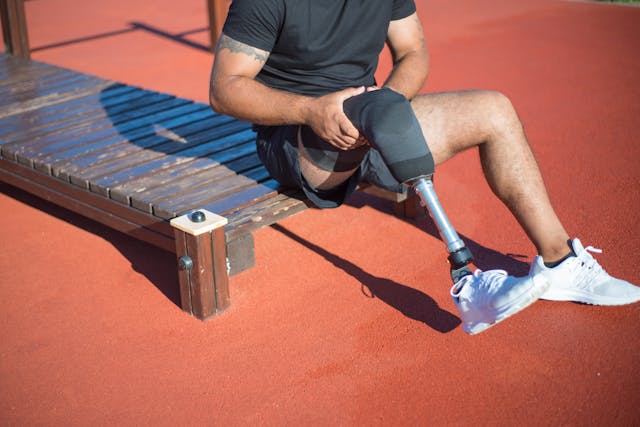
When not in use, the prosthetic should be stored in a dry, cool place to prevent unnecessary exposure to humidity or extreme temperatures. Keeping it in a protective case when traveling ensures that it remains safe from accidental damage.
At Robobionics, we provide detailed care instructions and ongoing support to help parents and children keep their prosthetic in excellent condition for years to come.
7. Overcoming Challenges and Addressing Common Concerns
Even with all the benefits of a waterproof prosthetic, some common concerns may arise. Here’s how to handle them effectively.
“Will My Child’s Prosthetic Get Heavy in Water?”
Waterproof prosthetics are designed to be lightweight, but water may slightly change the way they feel when submerged. Some children may notice increased resistance in water or a change in buoyancy.
Solution: Encourage your child to practice movement in water gradually. Their body will naturally adjust as they build muscle memory and develop balance.
“Will the Prosthetic Slip Off in Water?”
Since water can reduce friction between the skin and the socket, parents may worry about the prosthetic slipping off.
Solution: Using secure straps, waterproof liners, or suction sockets can improve grip and stability. A prosthetist can recommend the best fit and adjustments to prevent slippage.
“Is It Worth the Cost?”
Waterproof prosthetics are an investment, but they enhance a child’s quality of life, allowing them to play freely, stay active, and enjoy water activities without fear.
Solution: Compare long-term benefits—fewer replacements, reduced damage, and more independence mean that the cost often balances out over time. Additionally, some insurance providers or disability programs may offer assistance for waterproof prosthetics.
At Robobionics, we work with families to find the most cost-effective and high-quality solutions for their child’s needs.
8. A Future of Greater Possibilities: Innovations in Waterproof Prosthetics
Prosthetic technology is evolving rapidly, and waterproof prosthetics are becoming more advanced, more affordable, and more adaptable than ever before.
The Rise of Smart Waterproof Prosthetics
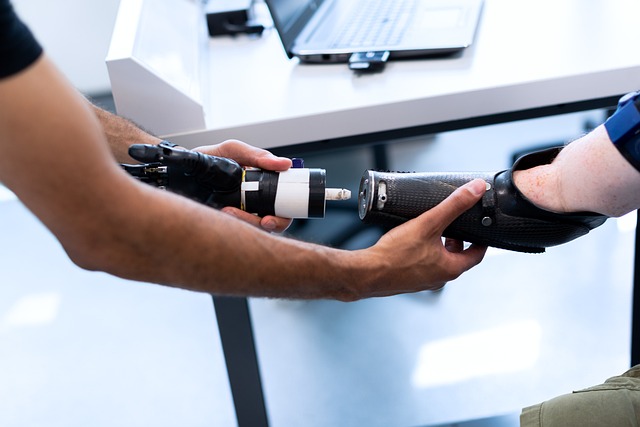
Future waterproof prosthetics may feature integrated sensors that provide feedback on pressure, movement, and even temperature. This could help children improve coordination in water and allow for greater control while swimming or engaging in sports.
At Robobionics, we stay at the forefront of prosthetic innovation, ensuring that children receive the most advanced and practical solutions available.
Lighter, More Flexible Designs for Natural Movement
As technology advances, waterproof prosthetics are becoming lighter and more flexible, providing a more natural feel in water. Newer designs focus on improved balance, better grip, and streamlined movement, making water activities even easier and more enjoyable.
Customizable, modular prosthetics are also being developed, allowing for quick adjustments as children grow or as their activity levels change. This means fewer replacements and greater long-term usability.
Making Waterproof Prosthetics More Accessible
With ongoing improvements in manufacturing and materials, waterproof prosthetics are becoming more cost-effective, making them accessible to more families. 3D printing technology is also playing a major role in making custom waterproof prosthetics affordable, lightweight, and durable.
At Robobionics, we are dedicated to making high-quality waterproof prosthetics available to families across India, ensuring that no child has to miss out on the experiences they love.
9. Making the Decision: Is a Waterproof Prosthetic Right for Your Child?
Every child is unique, and the decision to invest in a waterproof prosthetic depends on their lifestyle, activities, and personal needs.
When a Waterproof Prosthetic is a Great Choice:
- Your child loves swimming, water sports, or outdoor play.
- You want to simplify bath time and hygiene routines.
- Your child is active and wants more freedom in daily life.
- You want to prevent wear and tear from moisture exposure.
- Your child enjoys exploring, running, and playing in all conditions.
If any of these apply to your child, a waterproof prosthetic could make a huge difference in their daily comfort, confidence, and independence.
However, if your child’s prosthetic rarely comes into contact with water, a standard prosthetic may be sufficient. A prosthetist can help assess whether a waterproof limb is the right investment for your child’s specific needs.
At Robobionics, we offer personalized consultations to help parents determine the best prosthetic solution for their child’s lifestyle.
Final Thoughts: Are Waterproof Prosthetics Worth It?
For children who love swimming, outdoor adventures, and water play, waterproof prosthetics can be life-changing. They provide freedom, comfort, and durability, allowing kids to fully engage in activities without limitations.
While they may have a higher initial cost, the long-term benefits—including increased usability, longer lifespan, and better hygiene—make them a valuable investment for active children.
At Robobionics, we are dedicated to providing high-quality waterproof prosthetics that empower children to move confidently in any environment.
🚀 Want to explore waterproof prosthetic options for your child? Book a free consultation with our experts today!
💡 Have questions? Contact us now and let’s find the perfect waterproof prosthetic for your child’s needs!



